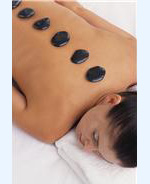Hippocrates defined medicine as “the art of rubbing.” Sounds an awful lot like massage doesn’t it?
Overview of Massage
 Massage has been used for thousands of years around the world. There are many different forms of massage with most having the common purpose of promoting relaxation in the body through touch. Using primarily their hands and fingers massage therapists stimulate the muscles, tissues and acupressure points on a person’s body to improve circulation, relieve tension, and enhance that person’s overall well-being. Although often considered a luxury in the West, massage therapy is a major component of the Ayurveda practice of detoxification called panchakarma.
Massage has been used for thousands of years around the world. There are many different forms of massage with most having the common purpose of promoting relaxation in the body through touch. Using primarily their hands and fingers massage therapists stimulate the muscles, tissues and acupressure points on a person’s body to improve circulation, relieve tension, and enhance that person’s overall well-being. Although often considered a luxury in the West, massage therapy is a major component of the Ayurveda practice of detoxification called panchakarma.
Benefits of Massage Therapy
For most people the primary benefit of massage is that it is relaxing and simply feels good. Yet, massage has an impact on our biology and can:
- Improve muscle tone
- Reduce cortisol levels
- Increase circulation
- Release toxins stored in the muscles and tissues
- Enhance digestion
- Recent studies have also shown massage can enhance immune function, improve asthma symptoms, aid carpal tunnel syndrome responses, and promote weight gain in newborns.
Styles of Massage
- Swedish Massage – the most popular and common form of massage in the US, it is generally done over the entire body using oil along with long gliding strokes (effleurage), as well as, tapping and kneading to relax muscles.
- Hot Stone Massage – a variation of a full-body Swedish massage that uses smooth, hot stones to get deeply into the muscles.
- Deep Tissue Massage – a deep form of massage that focuses on the muscle fibers and includes acupressure and an emphasis on trigger-points.
- Shiatsu Massage – based on the meridian system of Chinese Medicine, this style focuses more on the acupressure points to remove energy blocks, and optimize the flow of chi (qi). This form of massage does not require the client to remove their clothing.
Maximizing a Massage
When receiving a massage there is very little for you to do accept lie back and completely relax. However, the following tips will maximize the benefits of the massage:
- Do not have a massage if you the flu or have an active disease (i.e. metastasizing cancer) because the enhanced circulation could make your condition worse.
- Always tell your massage therapist about any medical conditions, allergies, sensitivities, or areas of discomfort.
- Do not drink alcohol or consume a large meal before a massage.
- Combine the benefits of aromatherapy with massage by requesting the use of relaxing essential oils like lavender in a base of a vegetable/plant oil like jojoba or almond oil.
- Drink ample filtered water or caffeine-free herbal tea following a massage to rehydrate. Avoid alcohol or caffeine for at least 12 hours so the body can fully detox.
- If possible don’t shower following a massage so that the oils can be absorbed into the skin.
Finding a Trained Massage Therapist
It is important to work with a fully-trained and licensed massage therapist. The following agencies and sites can help you find massage therapists and massage therapy schools which often offer access to free massages from students:
- Find a massage therapist and accredited schools through the American Massage Therapy Association, or find a certified massage therapist through the National Certification Board for Therapeutic Massage & Bodywork.
- Find an accredited massage school from the Commission on Massage Therapy Accreditation .
Self Massage
If you can’t make it to a trained massage therapist, why not take matters into your own hands? There are a variety of cooling foot creams containing peppermint oil that can be massaged into the feet for a relaxing treat. You can even make your own by using a drop of peppermint oil or lavender oil mixed with a carrier oil such a jojoba, coconut, or almond oil. For simple steps for an easy, stress-relieving massage called a “Self-Abhy” visit the Chopra Center’s website.
Massage Resources
American Massage Therapy Association – www.amtamassage.org
Associated Bodywork and Massage Professionals – www.abmp.com
Commission on Massage Therapy Accreditation (COMTA) – www.comta.org
Hartford Hospital –Creating a Massage Therapy Program – www.hartfordhealth.org/IntMed/manual/massage.asp
Healthy.net –Massage & Bodywork – www.healthy.net/Alternative_Therapy/Massage_Bodywork/5 – *This site sells products so some information could be biased.
National Center for Complementary and Alternative Medicine (NCCAM) – Massage – http://nccam.nih.gov/health/massage
National Certification Board for Therapeutic Massage and Bodywork – www.ncbtmb.com
References:
Riley, D., Ehling, D. & Sancier, K. (2004). Chapter 11: Movement and Body-Centered Therapies in Integrative Medicine. McGraw Hill Companies.
Petersen, A. Don’t Call it Pampering: Massage Wants to Be Medicine. The Wall Street Journal March 13, 2012.
[Last Updated: 9/13/12]

Comments are closed.